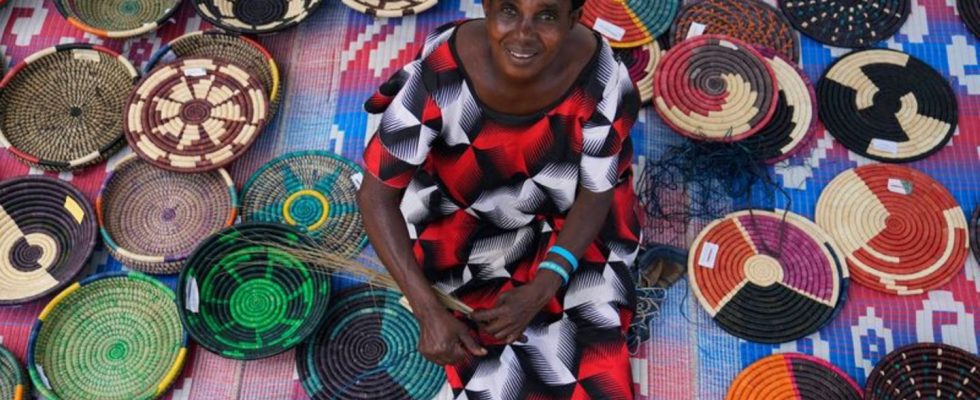30 years after the genocide, Rwanda is wooing investors, including from Germany, with a clean image. But things are looking bad with freedom of the press and freedom of expression.
If there is an African “phoenix rising from the ashes”, it would probably be Rwanda. 30 years after the genocide in the small East African country, Rwanda, with its thousand hills and the capital Kigali, is popular with investors, including from Germany.
Clean streets, low crime, hardly any corruption – that is not a given in large African cities. The World Bank lists the landlocked country the size of Mecklenburg-Western Pomerania as the second best place to do business in sub-Saharan Africa. But when it comes to freedom of the press or opposition politicians, the country reveals its dark side.
The genocide 30 years ago
The cruelest and bloodiest chapter in the history of the small state is now three decades ago: On April 7th, the genocide in 1994 is remembered throughout the country. The specific reason was the still-unexplained shooting down of Rwandan President Juvenal Habyarimana’s plane on April 6, 1994. Shortly afterwards, the Hutu government called on the radio to kill all Tutsis.
However, there had been warning signs much earlier. Hate slogans have been fueling sentiment against the Tutsi minority for months. As early as January 1994, the Canadian commander of the UN peacekeeping mission in Rwanda warned the New York UN headquarters of a possible genocide in Rwanda. However, without a corresponding mandate from the UN Security Council, he was not allowed to take action against weapons depots belonging to Hutu militias.
In just 100 days, Hutu militias murdered at least 800,000 Tutsi and moderate Hutus. The victims were literally dismembered with machetes or burned alive. It was the sad culmination of ethnic tensions and competition that were still based on colonial origins.
The genocide in Rwanda is now also seen as a failure of the international community, which reacted late and initially hesitantly. The fact that the killing came to an end is also thanks to the man who was at the head of the state today: Paul Kagame, the leader of the Rwandan Patriotic Front (RPF), marched his troops into Rwanda from exile in Uganda and took up the fight with government troops and Hutu militias. The further they advanced, the more clearly the full extent of the genocide became apparent.
Criticism of the persecution of opposition figures
Today, the former rebel leader Kagame is not only firmly in the saddle as Rwanda’s strong man, he also rules his country in an authoritarian manner. The 66-year-old is aiming for a fourth re-election as president in the parliamentary and presidential elections in July. Nobody doubts the foreseeable result – not least because political opposition has a difficult time in Rwanda and a leading opposition politician is not allowed to stand for election.
Human rights organizations criticize Kagame for the persecution of critical politicians, journalists and other opponents. “Anyone who dares to criticize government policy or President Paul Kagame is taking a high risk – and even those who flee abroad to avoid persecution will not be safe there,” emphasized Lewis Mudge of the human rights organization Human Right Watch in January the presentation of a report on attacks on opposition figures abroad.
The law against genocide denial, comparable to the criminalization of denial of Nazi crimes in Germany, is also used to silence government critics. “The presidential and parliamentary elections of recent years did not meet international democratic standards,” it says on the website of the Federal Ministry for Economic Cooperation (BMZ) about Rwanda.
Model country and “Switzerland of Africa”?
The government in Kigali is also criticized for its role in the conflict in eastern Congo. The Democratic Republic of Congo, but also international experts, accuse Rwanda of supporting the M23 militia in the neighboring country, which controls large parts of the North Kivu province on the border with Rwanda.
Nevertheless, Rwanda is considered a model country in some respects and is often referred to as the “Switzerland of Africa”. On the one hand, because of the literally clean image, Kagame’s successful action against littering and corruption, which are no longer an issue here. But when it comes to the promotion of women, Rwanda is not only doing well in African comparison: in no other parliament in the world is the proportion of women as high as in Rwanda – it is currently 61 percent. However, as in most African countries, in Rwanda the parliament does not play a prominent role in shaping the state.
German commitment
Germany is involved in Rwanda, among other things, through projects run by GIZ and KfW. For example, as part of a climate partnership between Germany and Rwanda agreed in 2022, climate protection, adaptation to climate change and urban development will be promoted. This includes the “Green City Kigali” project, which is supported by KfW.
A green district with climate-friendly houses for over 7,000 people is being created here. Other examples of German-Rwandan cooperation include Biontech’s African mRNA production facility in Kigali and a joint pilot project by Siemens and Volkswagen on electromobility.
According to its own future strategy, Rwanda wants to become a middle-income country by 2035 – and even reach a high income level by 2050. These are ambitious goals for the country, which wants to finally free itself from the shadow of the genocide, but without forgetting it.

